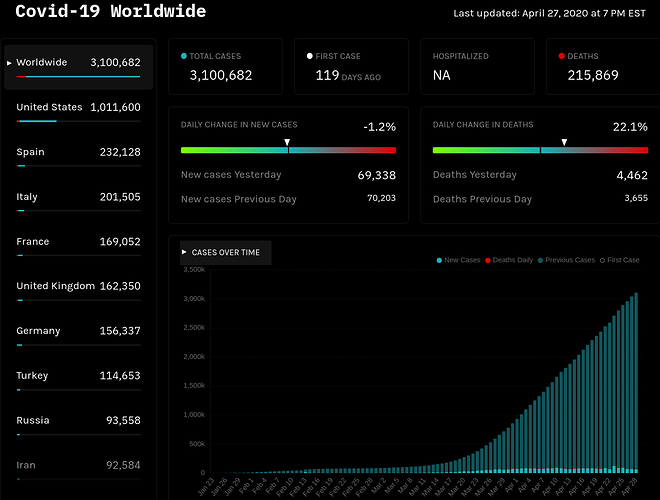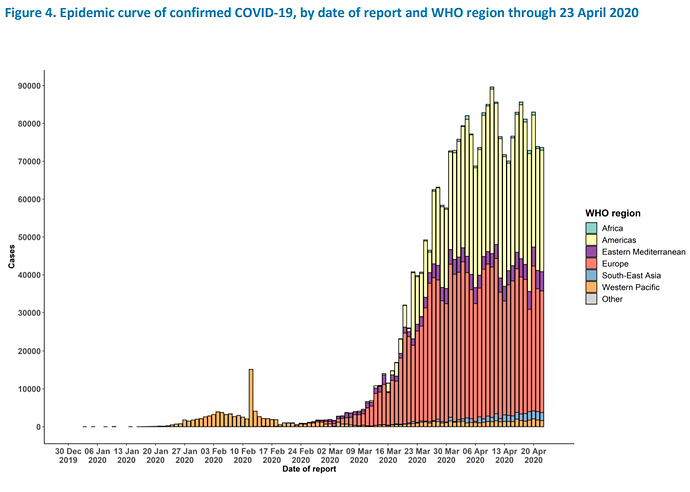I’m curious… I wonder if UVC will remove the IR spectrum from plastic?
It must be me… I drive people away from threads… I have no clue…
UV waves are way shorter than microwave actually ![]() UV is in the 10-400 nm range, whereas microwaves are in the 1,000,000-1,000,000,000 nm range
UV is in the 10-400 nm range, whereas microwaves are in the 1,000,000-1,000,000,000 nm range ![]() Come to think of it, microwaves is kind of a silly name…
Come to think of it, microwaves is kind of a silly name…
Sorry… My confusion… (of course). Approaching X-rays
Checking back in with our Valued Customers
Our commitment to you has never been stronger
As the coronavirus (COVID-19) reality evolves and forces changes in all of our lives in ways we could never have imagined, I’m reaching out to update you on our response, and how we continue to support you through this period.
At this time of disruption, distancing and uncertainty, staying connected has never been more important. Whether for a hospital, a scientist, first responder, teacher, family or a small business — staying connected will be a key part of seeing our country to the other side of this crisis.
More relief for our customers, for society, and those who give the most
With that in mind, we’re pleased to extend our commitment through June 30th to waive late fees and to not terminate service for those consumers and small businesses who are unable to pay due to disruptions caused by the coronavirus pandemic. Customers who notify us will also be automatically enrolled in a program to help manage payments.
We’re also:
• Automatically adding an additional 15GB of 4G LTE data for you to use from May 1st through May 31st to learn, work or keep connected during this challenging time;
• Giving you free access to learning tools to help with ongoing engagement during our new normal;
• Continuing our low-income internet option for new Fios Internet customers and waiving router charges for two months;
• Extending our “Those who serve” discounts now, and moving forward, to include nurses and teachers, in addition to first responders, veterans, and active-duty military who already benefit from our best pricing for Verizon Wireless and Fios Internet service. Many of our heroes already rely on America’s most reliable networks to keep them connected and this is a way for us to thank them for everything they do during this challenging time, and always.
We’ve now committed over $50 million in contributions and donations to nonprofits, including No Kid Hungry, the American Red Cross, and the CDP COVID-19 Solidarity Response Fund for WHO. And in partnership with the New York Times, we’re giving 14 million high school students within the U.S. free digital access to NYTimes.com.
(The Conversation, April 27, 2020):
“The coronavirus genome is like a shipping label that lets epidemiologists track where it’s been”
Using the GISAID estimated mutation rate and the phylogenetic tree, scientists think the first time the coronavirus infected a person likely occurred in Wuhan in November or early December 2019.
Likely (more) than you ever wanted to know about COVID-19 immunoglobulin serology. For nerds:
(Diazyme Corp): “Why Do We Need Antibody Tests for COVID-19 and How to Interpret Test Results”
IgG/IgM serological tests offer some advantages over RT-qPCR. Firstly, serological tests detect human antibodies (proteins belonging to the immunoglobulin class) which are known to be much more stable than viral RNA. As a result, IgM/IgG serological specimens are less sensitive to spoilage during collection, transport, storage and testing than RT-qPCR specimens. Secondly, because antibodies are typically uniformly distributed in the blood, serological specimens have much less variations than nasopharyngeal viral RNA specimens and can be easily collected with minor phlebotomy discomfort to the patient. Thirdly, unlike RT-qPCR, serological tests can detect past infection because virus-specific antibodies (unlike viral RNA) can persist in the blood for several weeks/months after symptom onset.
IgM/IgG serological tests also have some limitations, mainly related to the slow pace of the human antibody response to SARS-CoV-2. Although, several studies are still on-going, SARS-CoV-2 antibodies may not be detectable before 3 days after onset of symptoms (or at least 7 to 10 days after infection).
While IgM/IgG serological tests alone may not be enough to diagnose COVID-19, they can be a valuable diagnostic tool when combined with RT-qPCR (see section below). In addition, because of their scalability, serological assays can be used in large-scale, whole-population, testing to assess the overall immune response to the virus and identify asymptomatic carriers of the virus. Indeed, 20-80% of COVID-19 cases are estimated to be asymptomatic.
Figure 1: Variation of the Levels of SARS-CoV-2 RNA and Antigen, IgM and IgG after infection.
Source: http://www.diazyme.com/Websites/diazyme/images/covid19/figure1.png
.
(Science Magazine, April 2, 2020):
“Antibody Tests for the Coronavirus”
For determining whether or not a person has developed antibodies against the new coronavirus, a typical test would work like this: drops of blood are absorbed onto a “sample pad” at one end of the test device. That soaks up red blood cells … and lets the plasma soak along a laminate of what’s essentially paper. The first thing it encounters is a zone that has known coronavirus antigens (such as pieces of the spike proteins, etc.), which pieces are also linked, in the most common form, to tiny particles of colloidal gold metal. If the plasma has antibodies to the coronavirus proteins, those will bind to the test antigens and carry them (and their colloidal gold particles) along up the strip. Then it runs into three zones on the paper, narrow strips that are impregnated with “antibodies to antibodies” (yep, that’s a real thing).
I didn’t go into the various subclasses of antibodies in my quick explanation above (and yes, by immunology standards that was about as short as it gets!) But the tests are looking for two antibody subclasses, IgG and IgM. The IgM ones are the first that get produced in an immune response, mostly coming from the spleen, but they’re also relatively short-lived, with a half-life of five or six days. So detection of IgM against coronavirus antigens indicates a recent (or still active) infection. The IgG antibodies are more numerous in the end, though, and for many infections (measles, chickenpox, mumps, hepatitis B and more) they indicate that a person is now immune to re-infection.
.
… there are seven different coronaviruses that cause illness in humans, including several that cause mild symptoms like the common cold. Our antibodies for each coronavirus appear similar, so deciphering between the common cold antibody and the Covid-19 antibody is a real challenge scientifically, Sepkowitz said.
So true - but often being overlooked (even in clinical diagnoses). SARS-CoV-2 is a cryptic invader.
(Kaiser Health News, April 24, 2020):
(STAT Opinion, April 27, 2020):
“Scientists who express different views on Covid-19 should be heard, not demonized”
When major decisions must be made amid high scientific uncertainty, as is the case with Covid-19, we can’t afford to silence or demonize professional colleagues with heterodox views. Even worse, we can’t allow questions of science, medicine, and public health to become captives of tribalized politics. Today, more than ever, we need vigorous academic debate. … we are concerned by a chilling attitude among some scholars and academics, who are wrongly ascribing legitimate disagreements about Covid-19 to ignorance or to questionable political or other motivations. …
… We are two academic physicians with different career interests who sometimes disagree on substantive issues. But we share the view that vigorous debate is fundamental to the existence of universities, where individuals with different ideas who have a commitment to reason compete to persuade others based on evidence, data, and reason. Now is the time to foster - not stifle - open dialogue among academic physicians and scientists about the current pandemic and the best tactical responses to it, each of which involve enormous trade-offs and unanticipated consequences. …
… there are emerging answers and we tend to share the consensus views … At the same time, academics must be able to express a broad range of interpretations and opinions.
From Nature, Apr. 27th
https://www.nature.com/articles/s41586-020-2271-3
…Levels of airborne SARS-CoV-2 RNA in the majority of public areas was undetectable except in two areas prone to crowding, possibly due to infected carriers in the crowd. We found that some medical staff areas initially had high concentrations of viral RNA with aerosol size distributions showing peaks in submicrometre and/or supermicrometre regions, but these levels were reduced to undetectable levels after implementation of rigorous sanitization procedures.
Although we have not established the infectivity of the virus detected in these hospital areas, we propose that SARS-CoV-2 may have the potential to be transmitted via aerosols. Our results indicate that room ventilation, open space, sanitization of protective apparel, and proper use and disinfection of toilet areas can effectively limit the concentration of SARS-CoV-2 RNA in aerosols. Future work should explore the infectivity of aerosolized virus.
So we should wear full face P100-masks when we go out?! ![]()
Here’s a scenario that describes reopening business in MIchigan in real terms.
My (I’m not the owner) floorcovering store has been trying to find out if it can reopen. Consulting with the local police, they will not arbitrarily police businesses to see if they are open or not however if some crazed liberal complains they will have to respond. This is where it becomes dicy. They have no finite criteria to make a determination if the store is “legally” open. We contacted our state representitive and received this response:
Thank you for reaching out to Rep. Vaupel regarding whether your business can now operate or not. After discussing with Rep. Vaupel and a few other policy staffers in our caucus, we all agreed that under the new EO, your business will be able to open back up again as long as you can provide curbside/delivery to all customers, but you likely can’t install unless you’re deemed essential by an essential businesses and your services (carpet installation) is deemed necessary for the critical operations of that essential business. Let me know if you have any other questions or concerns.
Here again, nothing definite. Bottom line, Michigan is still in the dark, but we knew that.
Excellent summary of advice re: covid!
The University of Washington’s Institute for Health Metrics and Evaluation (IHME) model this week increased its projected U.S. coronavirus death toll as a number of states move to reopen businesses. The projected number of deaths rose from 67,641 a week ago to 74,073, IHME said in a statement on Monday. The new figure is still lower than a projection last month of 90,000 deaths in the U.S. related to coronavirus. The new IHME estimate now ranges from 56,563 to 130,666 deaths in the U.S. The institute said that the increase is due to “many states experiencing flatter and thus longer epidemic peaks.” It also said that coronavirus deaths across the country are not falling “very quickly” after their estimated peak.
(MIT Technology Review, April 27, 2020):
What the Columbia researchers now describe in a preliminary report is cause for concern. They found that people frequently got reinfected with the same coronavirus, even in the same year, and sometimes more than once. Over a year and a half, a dozen of the volunteers tested positive two or three times for the same virus, in one case with just four weeks between positive results.
That’s a stark difference from the pattern with infections like measles or chicken pox, where people who recover can expect to be immune for life. For the coronaviruses “immunity seems to wane quickly,” says Jeffrey Shaman, who carried out the research with Marta Galanti, a postdoctoral researcher. …
… What’s unknown is how long immunity lasts - and only five months into the outbreak, there is no way to know. If it’s for life, then every survivor will add to a permanent bulwark against the pathogen’s spread. But if immunity is short, as it is for the common coronaviruses, covid-19 could set itself up as a seasonal superflu with a high fatality rate - one that emerges in a nasty wave winter after winter. …
… Because so many other human coronaviruses are mild, they haven’t gotten the same attention as influenza, a shape-shifting virus that is closely followed and genetically analyzed to create a new vaccine each year. But it’s not even known, for instance, whether the common coronaviruses mutate in ways that let them evade the immune system, or whether there are other reasons immunity is so short-lived. …
… One finding of the research is that people who got the same coronavirus twice didn’t have fewer symptoms the second time. Instead, some people never got symptoms at all; others had bad colds two or three times. Shaman says the severity of infection tended to run in families, suggesting a genetic basis.
The big question is what this fizzling, short-lived resistance to common cold viruses means for covid-19. Is there a chance the disease will turn into a killer version of the common cold, constantly out there, infecting 10% or 20% of the population each year, but also continuing to kill one in a hundred? If so, it would amount to a plague capable of shaving the current rate of world population growth by a tenth.
Handy Global Tracker Map for Covid-19; Updates regularly.
Another (STAT News associated) “dashboard” for the curious. Note that the total (known) cases have (in part, presumably, as a result of measures taken worldwide) been slowed to a linearly increasing slope:
Certainly better than an (exponentially) increasing slope - but (new) cases remain at a constant level:
Source (April 23, 2020): https://www.who.int/docs/default-source/coronaviruse/situation-reports/20200423-sitrep-94-covid-19.pdf
Blockquote So we should wear full face P100-masks when we go out?!
That means I’d have to wear my 1/2 mask respirator. The P100 masks are outrageous and rare to find.
(Perhaps), he was merely jesting, Captain ? 
He may jest, but it’s been my quest… Only 1 found. they’re $14 each. That’s for the masks. having to wear the masks would be to expensive for me. I’ll have to wear 2 N95’s and hope.
Be aware (as you may already be) that a single (properly fitted) N95 type mask is rather hard to inspire air through (making them dangerous for the pulmonary/cardiovascular compromised, especially if any even mild exertion is involved). “Cascaded” N95s would square the diminished fraction of incoming air-flow. Perhaps more likely to put one in their grave than COVID-19 itself. But one would be “safely dead”.
(Or), did you perchance mean as dual-mounted upon one’s face (looking like a strange brassiere) ?


Captain, I am flummoxed as why you would not just follow latest Presidential Recommendations:
Yes thank you, I saw that. Morning Joe is one of my views if not for just waiting for Joe to blow his stack and see Mika roll her eyes 





